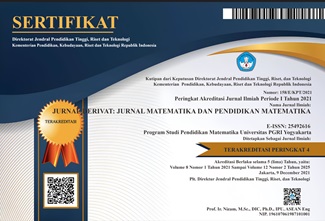Model Susceptible-Infected-Recovered (SIR) Dampak Penerapan PSBB Terhadap Kasus Covid-19 Di Pekanbaru
DOI:
https://doi.org/10.31316/jderivat.v11i1.4698Abstract
Covid-19 has become a global pandemic in the 21st century. Various efforts to control its spread have been made. Isolation or regional quarantine is one of the efforts made by almost all countries in the world. Indonesia modified the lockdown by implementing 'Large-Scale Social Restrictions (PSBB)'. Before and during the implementation of PSBB, there have been many pros and cons in the community. By using the SIR model and Euler method, the impact before and after the implementation of PSBB in Pekanbaru city is compared. Based on daily data of Covid-19 cases in Pekanbaru city, it is obtained that the value of the basic reproduction number before and after the implementation of PSBB are and respectivel. This condition confirms that either without or by implementing PSBB, Pekanbaru city will be free from Covid-19. Simulation of Covid-19 cases before and after PSBB graphically also shows a situation that will be free from disease. However, without implementing PSBB, the number of infected will jump drastically after some time even though it will eventually decrease, while by implementing PSBB there is no spike. Thus, the implementation of PSBB can be an alternative to control Covid-19.
Keywords: Basic reproduction number, Covid-19, PSBB, SIR model, Euler methods.
References
Adi-kusumo, F., Susyanto, N., Endrayanto, I., & Meliala, A. (2020). SIR- Based Model In Predicting The Early Outbreak Of Covid-19 In The Special Region Of Yogyakarta ( DIY). Jurnal Matematika Thales, 02, 1–10.
Handayanto, R. T., & Herlawati, H. (2020). Efektifitas Pembatasan Sosial Berskala Besar (PSBB) di Kota Bekasi Dalam Mengatasi COVID-19 dengan Model Susceptible-Infected-Recovered (SIR). Jurnal Kajian Ilmiah, 20(2), 119–124. https://doi.org/10.31599/jki.v20i2.119
Kermack, A. W. O., Mckendrick, A. G., Kermack, W., & Mckendrick, A. G. (2014). A Contribution to the Mathematical Theory of Epidemics A Gontribution to the Mathematical Theory of Epidemics . 115(772), 700–721.
Nishiura, H., Linton, N. M., & Akhmetzhanov, A. R. (2020). Serial interval of novel coronavirus ( COVID-19) infections. International Journal of Infectious Diseases, 93, 284–286. https://doi.org/10.1016/j.ijid.2020.02.060
Nuha, A. R., & Yahya, L. (2021). Analisis Dinamik Model Transmisi COVID-19 dengan Melibatkan Intervensi Karantina. 3(1), 66–79.
Puspita Sari, S., & Arfi, E. (2021). Analisis Dinamik Model SIR Pada Kasus Penyebaran Penyakit Corona Virus Disease-19 (COVID-19). Indonesian Journal of Applied Mathematics, 1(2), 61–68.
Putra, V. G., Wijayono, A., Ningsih, J., & Rosyidin, C. (2020). Penerapan Fisika Komputasi dengan MATLAB / Simulink pada Pemodelan Infeksi Wabah COVID-19 di Indonesia melalui Modifikasi Persamaan Differensial Bernoulli. 08(02), 107–118.
Sifriyani, S., Mulawarman, U., Rosadi, D., & Mada, U. G. (2020). Pemodelan Susceptible Infected Recovered ( SIR ) Untuk Estimasi Angka Reproduksi Covid-19 Di Kalimantan Timur Dan Samarinda. July.
Sitinjak, A. (2021). Penentuan Rumus Bilangan Reproduksi Dasar Pada Model Matematika Covid-19 Dari Model Sir Yang Dimodifikasi. EduMatSains, 5(2), 203–210.
Teguh, R., Sagit, A., & Adji, F. F. (2020). Pemodelan Penyebaran Infeksi Covid-19 Di Kalimantan, 2020. 14(2), 171–178.
Downloads
Published
Issue
Section
Citation Check
License
Copyright (c) 2024 Mohammad Soleh Soleh, Melvy Utari Permadhi, Wartono, Irma Suryani, Elfira Safitri, Riry Sriningsih

This work is licensed under a Creative Commons Attribution-ShareAlike 4.0 International License.
Authors who publish with this journal agree to the following terms:
-
Authors retain copyright and grant the journal right of first publication with the work simultaneously licensed under a Creative Commons Attribution-ShareAlike 4.0 International License that allows others to share the work with an acknowledgment of the work's authorship and initial publication in this journal.
- Authors are able to enter into separate, additional contractual arrangements for the non-exclusive distribution of the journal's published version of the work (e.g., post it to an institutional repository or publish it in a book), with an acknowledgment of its initial publication in this journal.
- Authors are permitted and encouraged to post their work online (e.g., in institutional repositories or on their website) prior to and during the submission process, as it can lead to productive exchanges, as well as earlier and greater citation of published work (See The Effect of Open Access).







